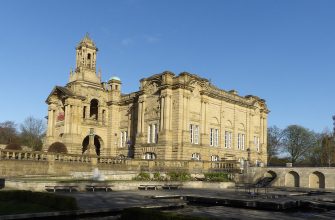Located in the heart of Gateshead, England, the BALTIC Centre for Contemporary Art is a vibrant cultural hub that has been captivating visitors since its opening in 2002. Housed in a converted flour mill on the south bank of the River Tyne, the BALTIC Centre is the largest dedicated contemporary art institution in North East England. With its dynamic exhibitions, innovative installations, and a diverse roster of artists, the gallery has established itself as a leading destination for contemporary art enthusiasts.
History of the BALTIC Centre
The BALTIC Centre for Contemporary Art is housed in a landmark industrial building that was originally a flour mill. The mill was built in 1950 but ceased operations in 1981. After two decades of disuse, the building was transformed into a contemporary art centre. The conversion, which took place between 1998 and 2002, preserved the building’s industrial character while creating a modern, spacious interior suitable for displaying a wide range of artworks.
What to See at the BALTIC Centre
The BALTIC Centre hosts a constantly changing programme of exhibitions and events. The gallery spaces are large and flexible, allowing for the display of a wide variety of artworks, from large-scale installations to smaller, more intimate pieces. Artists from around the world have exhibited their work at the BALTIC Centre, including renowned figures like Yoko Ono, Damien Hirst, and Antony Gormley.
- The BALTIC Centre’s permanent collection includes works by many of the artists who have exhibited there.
- The gallery also hosts regular temporary exhibitions, showcasing the latest trends in contemporary art.
- In addition to the exhibitions, the BALTIC Centre offers a range of events and activities, including artist talks, workshops, and film screenings.
Visiting the BALTIC Centre
Admission to the BALTIC Centre is free, although some special exhibitions and events may have an entry fee. The gallery is open every day, with extended opening hours on certain days. Guided tours are available, offering insights into the exhibitions and the history of the building.
- The BALTIC Centre is easily accessible by public transport, with several bus and metro stops nearby.
- There is a car park adjacent to the gallery for those travelling by car.
- The gallery has a shop selling a range of art books, prints, and gifts, as well as a café and restaurant with views over the River Tyne.
Tips for Tourists
Visitors to the BALTIC Centre should allow plenty of time to explore the exhibitions, as there is often a lot to see. Comfortable shoes are recommended, as the gallery spaces are large and spread over several floors. Photography is allowed in most areas of the gallery, but flash and tripods are not permitted. Finally, don’t miss the opportunity to take in the stunning views of the Newcastle skyline from the gallery’s viewing platform.
The BALTIC Centre for Contemporary Art is more than just a gallery – it’s a place where art comes to life, where artists and audiences can engage in dialogue, and where the boundaries of contemporary art are continually being pushed and redefined. Whether you’re a seasoned art lover or a curious newcomer, a visit to the BALTIC Centre is sure to be a memorable experience.








